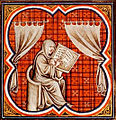Portal:Biography
The Biography Portal
A biography, or simply bio, is a detailed description of a person's life. It involves more than just basic facts like education, work, relationships, and death; it portrays a person's experience of these life events. Unlike a profile or curriculum vitae (résumé), a biography presents a subject's life story, highlighting various aspects of their life, including intimate details of experience, and may include an analysis of the subject's personality.
Biographical works are usually non-fiction, but fiction can also be used to portray a person's life. One in-depth form of biographical coverage is called legacy writing. Works in diverse media, from literature to film, form the genre known as biography.
An authorized biography is written with the permission, cooperation, and at times, participation of a subject or a subject's heirs. An autobiography is written by the person themselves, sometimes with the assistance of a collaborator or ghostwriter. (Full article...)
Featured biographies –
Enlisting in the Union Navy in 1864, Bush served as a sailor aboard USS Vandalia and the captured Confederate vessel USS Beauregard, which maintained the blockade of the ports of the Confederacy. He was discharged from service in 1865 after an injury, which developed into a chronic condition in later life. The impoverished Bush was unable to return to Hawaii for more than a decade, during which time he traveled through New England and much of the Pacific. Back in Hawaii, he worked as a government tax collector and road supervisor for the island of Kauai, where he settled down. In later life, he converted to Mormonism and became an active member of the Hawaiian Mission. After the annexation of Hawaii to the United States, Bush was recognized for his military service, and in 1905 was granted a government pension for the injuries he received in the Navy. He died at his home on Kauai on April 24, 1906. (Full article...)
Stephen I, also known as King Saint Stephen (Hungarian: Szent István király [ˌsɛnt ˈiʃtvaːn kiraːj]; Latin: Sanctus Stephanus; Slovak: Štefan I. or Štefan Veľký; c. 975 – 15 August 1038), was the last Grand Prince of the Hungarians between 997 and 1000 or 1001, and the first King of Hungary from 1000 or 1001, until his death in 1038. The year of his birth is uncertain, but many details of his life suggest that he was born in, or after, 975, in Esztergom. He was given the pagan name Vajk at birth, but the date of his baptism is unknown. He was the only son of Grand Prince Géza and his wife, Sarolt, who was descended from a prominent family of gyulas. Although both of his parents were baptized, Stephen was the first member of his family to become a devout Christian. He married Gisela of Bavaria, a scion of the imperial Ottonian dynasty.
After succeeding his father in 997, Stephen had to fight for the throne against his relative, Koppány, who was supported by large numbers of pagan warriors. He defeated Koppány with the assistance of foreign knights including Vecelin, Hont and Pázmány, and native lords. He was crowned on 25 December 1000 or 1 January 1001 with a crown sent by Pope Sylvester II. In a series of wars against semi-independent tribes and chieftains—including the Black Hungarians and his uncle, Gyula the Younger—he unified the Carpathian Basin. He protected the independence of his kingdom by forcing the invading troops of Conrad II, Holy Roman Emperor, to withdraw from Hungary in 1030. (Full article...)
Karl Jochen Rindt (German: [ˈjɔxn̩ ˈʁɪnt]; 18 April 1942 – 5 September 1970) was a German-born racing driver who spent most of his life in Austria and competed as an Austrian. In 1970, he was killed during practice for the Italian Grand Prix and became the only driver to be posthumously awarded the Formula One World Drivers' Championship.
Rindt started motor racing in 1961. Switching to single-seaters in 1963, he was successful in both Formula Junior and Formula Two. In 1964, Rindt made his debut in Formula One at the Austrian Grand Prix, before securing a full drive with Cooper for 1965. After mixed results with the team, he moved to Brabham for 1968 and then Lotus in 1969. It was at Lotus that Rindt found a competitive car, although he was often concerned about the safety of the notoriously unreliable Lotus vehicles. He won his first Formula One race at the 1969 United States Grand Prix. He had a very successful 1970 season, mainly racing the revolutionary Lotus 72, and won five of the first nine races. In practice for the Italian Grand Prix at Monza, he spun into the guardrails after a failure on his car's brake shaft, and a poorly installed crash barrier gave way. Rindt was pronounced dead while on the way to hospital. As his closest competitor Jacky Ickx was unable to score sufficient points in the remaining races of the season, Rindt was awarded the World Championship posthumously. Rindt left behind his wife, Nina, and a daughter, Natasha. (Full article...)
Megadeth is an American thrash metal band formed in Los Angeles in 1983 by vocalist/guitarist Dave Mustaine. Known for their technically complex guitar work and musicianship, Megadeth is one of the "big four" of American thrash metal along with Metallica, Anthrax, and Slayer, responsible for the genre's development and popularization. Their music features complex arrangements and fast rhythm sections, dual lead guitars, and lyrical themes of war, politics, religion, death, and personal relationships.
In 1985, Megadeth released their debut album, Killing Is My Business... and Business Is Good!, on the independent record label Combat Records, to moderate success. It caught the attention of bigger labels, which led to Megadeth signing with Capitol Records. Their first major-label album, Peace Sells... but Who's Buying?, was released in 1986 and was a major hit with the underground metal scene. Band members' substance abuse issues and personal disputes had brought Megadeth negative publicity during the late 1980s. Nonetheless, the band went on to release a number of platinum-selling albums, including So Far, So Good... So What! (1988), Rust in Peace (1990), and Countdown to Extinction (1992). These albums, along with worldwide tours, brought them public recognition. Megadeth's most recent album, The Sick, the Dying... and the Dead!, was released in 2022. (Full article...)
Air Vice-Marshal Francis Masson Bladin, CB, CBE (26 August 1898 – 2 February 1978) was a senior commander in the Royal Australian Air Force (RAAF). Born in rural Victoria, he graduated from the Royal Military College, Duntroon, in 1920. Bladin transferred from the Army to the Air Force in 1923, and learned to fly at RAAF Point Cook, Victoria. He held training appointments before taking command of No. 1 Squadron in 1934. Quiet but authoritative, he was nicknamed "Dad" in tribute to the concern he displayed for the welfare of his personnel.
Ranked wing commander at the outbreak of World War II, by September 1941 Bladin had been raised to temporary air commodore. He became Air Officer Commanding North-Western Area in March 1942, following the first Japanese air raids on Darwin, Northern Territory. Personally leading sorties against enemy territory, he earned the United States Silver Star for gallantry. In July 1943, Bladin was posted to No. 38 Group RAF in Europe, where he was mentioned in despatches. He was appointed a Commander of the Order of the British Empire the same year. (Full article...)
Mary Wollstonecraft (/ˈwʊlstənkræft/, also UK: /-krɑːft/; 27 April 1759 – 10 September 1797) was a British writer, philosopher, and advocate of women's rights. Until the late 20th century, Wollstonecraft's life, which encompassed several unconventional (at the time) personal relationships, received more attention than her writing. Wollstonecraft is regarded as one of the founding feminist philosophers, and feminists often cite both her life and her works as important influences.
During her brief career she wrote novels, treatises, a travel narrative, a history of the French Revolution, a conduct book, and a children's book. Wollstonecraft is best known for A Vindication of the Rights of Woman (1792), in which she argues that women are not naturally inferior to men but appear to be only because they lack education. She suggests that both men and women should be treated as rational beings and imagines a social order founded on reason. (Full article...)
August Edler von Meyszner (3 August 1886 – 24 January 1947) was an Austrian Gendarmerie officer, right-wing politician, and senior Ordnungspolizei (order police) officer who held the post of Higher SS and Police Leader in the German-occupied territory of Serbia from January 1942 to March 1944, during World War II. He has been described as one of Reichsführer-SS Heinrich Himmler's most brutal subordinates.
Meyszner began his career as an officer in the Gendarmerie, served on the Italian Front during World War I and reached the rank of Major der Polizei by 1921. He joined the Austrian Nazi Party in September 1925 and became a right-wing parliamentary deputy and provincial minister in the Austrian province of Styria in 1930. Due to his involvement with the Nazis, Meyszner was forcibly retired in 1933 and arrested in February 1934, but released after three months at the Wöllersdorf concentration camp. That July, he was rearrested following an attempted coup, but escaped police custody and fled to Nazi Germany, where he joined the Ordnungspolizei (Orpo) and then the Allgemeine SS. After police postings in Austria, Germany and occupied Norway, Himmler appointed Meyszner as Higher SS and Police Leader in Serbia in early 1942. He was one of few Orpo officers to be appointed to such a role. (Full article...)


















































